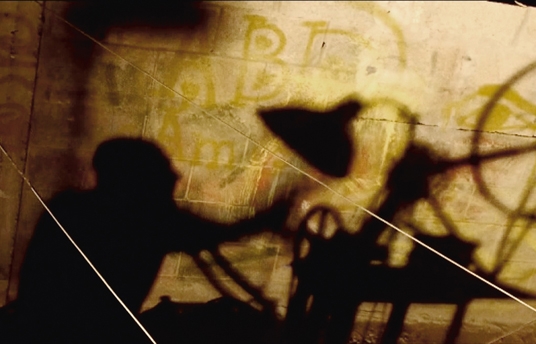نقد سينمائي: غزة 36 ملم
17 مارس 2013

لا يوجد صالات سينما في غزة.
خذ وقتاً كافياً لاستيعاب الفكرة، ثم نكمل.
“غزة 36 ملم” لخليل المزين فيلم وثائقي مؤثر يقدم معلومات عميقة أكثر من كونه يلخص تاريخ عرض الأفلام في غزة. يعرض لنا الفيلم لمحة عامة عن المسار العام لتاريخ السينما بعد الحرب العالمية الثانية في غزة، وشعبية الأفلام مباشرة بعد تلك الحرب، والمنافسة القوية بين صالات السينما وأهمية الأفلام من مصر ولبنان وأورويا وهوليوود في الستينات. كما يظهر المعارضة الإسلامية للسينما على أنها أوكار للدعارة والإباحية في السبعينات ويعرض الدمار المتتالي لصالات السينما في غزة.
النظر إلى ظهور واختفاء السسينما يشير إلى المشاكل والقضايا التي تواجه الثقافة الغزاوية والفلسطينية بشكل عام. والسؤال المطروح هنا: من خلال معارضة وخنق الثقافة الشعبية، هل تدعم الحركة الإسلامية في فلسطين الإحتلال من خلال تركيز الطاقات ضد شعبها؟ لقد اتجهت الحركة نحو التطرف، كما يشير موضوع الفيلم، وأحرقت دور العرض لضمان عدم مشاهدة أي مواد معارضة لها. كيف حصل هذا؟ ولماذا سمح بذلك؟
بالإضافة إلى ذلك، يطرح الفيلم أسئلة أكثر عمقاً: ما الذي أزيل مع تدمير السينما؟ ما الذي نفقده عندما لا نملك الفن؟ بعض الجواب يأتي من فنانين توأمين ساحرين (أيضاً ساهما في الفيلم) هما محمد وأحمد أبو نصر، المعروفين بإسمي طرزان وعرب. هما صانعا أفلام لم يحضرا إلى السينما قط، وفنانان لم يزورا أي صالة عرض، يتحدثان عن شغفهما بالأفلام وعن الحزن الذي يشعران به عند التجوال في صالات السينما المدمرة في غزة. يعبر التوأمين عن رغبتهما الجامحة بتلك التجربة، كما كثير من سكان العالم، بالجلوس في الظلام مع الأصدقاء والغرباء لمشاهدة الأفلام التي تعتبر قوة يمكن أن تحدث التغيير في الحياة. (لمزيد من المعلومات عن طرزان وعرب وعملهما، ادخل هنا و هنا).
بالرغم من أنه فيلم مركب لمدة ساعة، “غزة 36 ملم” فيلم قصير وشيق ومباشر. من الرائع أيضاً النظر إلى وابل الصور التي تشبع المشاهد عن القطع الميكانيكية والمعدات وجماليات الفيلم وصناعة الأفلام. إنه فيلم ذو شقين، واحد تجريبي شاعري وآخر توثيقي تاريخي اجتماعي. لكنه في النهاية ينعى – بطريقة راقية – شيئاً ما سلب من الشعب الفلسطيني.
نهاية الفيلم كانت رائعة تماماً، مع التوأمين يجلسان في الظلام ويشاهدان بعض أقدم اللقطات التي انتجت على الإطلاق: “الأخوة لوميير” في فيلم “عمال يغادرون مصنع لوميير“، وهي صورة مثالية لإلهام بداية جديدة للسينما في غزة.